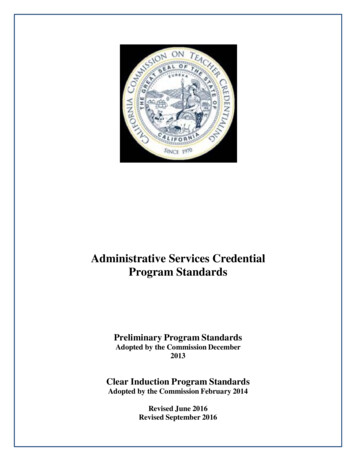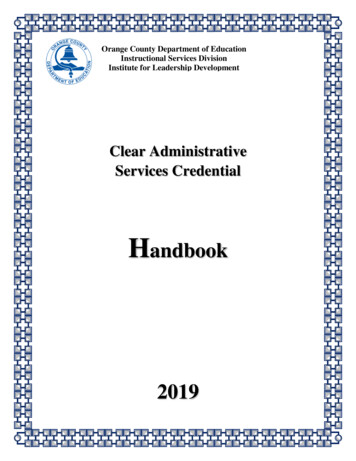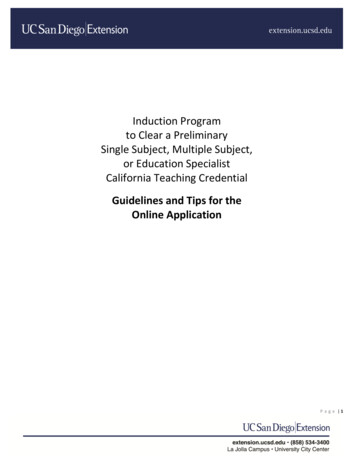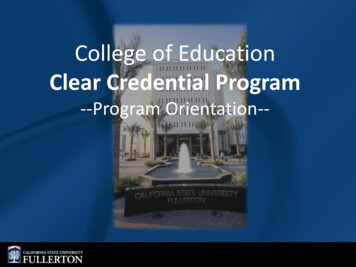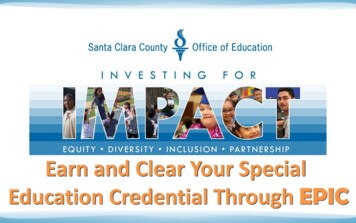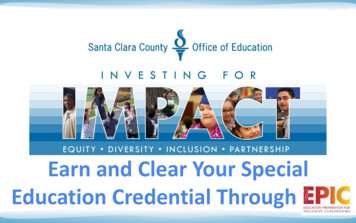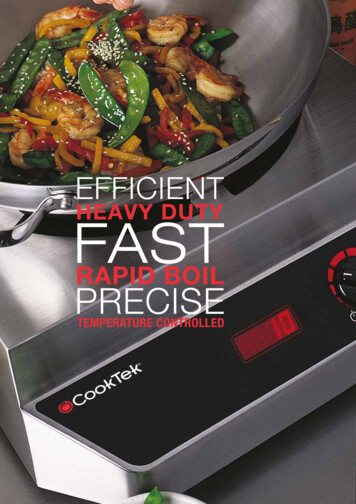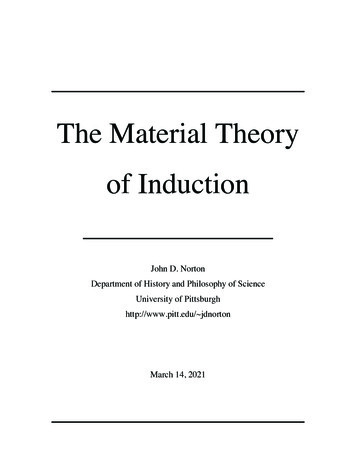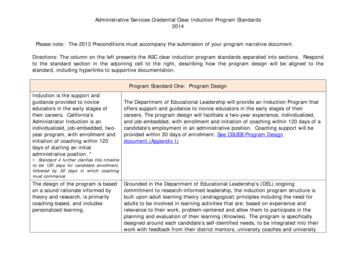
Transcription
Administrative Services Credential Clear Induction Program Standards2014Please note: The 2013 Preconditions must accompany the submission of your program narrative document.Directions: The column on the left presents the ASC clear induction program standards separated into sections. Respondto the standard section in the adjoining cell to the right, describing how the program design will be aligned to thestandard, including hyperlinks to supportive documentation.Program Standard One: Program DesignInduction is the support andguidance provided to noviceeducators in the early stages oftheir careers. California’sAdministrator Induction is anindividualized, job-embedded, twoyear program, with enrollment andinitiation of coaching within 120days of starting an initialadministrative position. *The Department of Educational Leadership will provide an Induction Program thatoffers support and guidance to novice educators in the early stages of theircareers. The program design will facilitate a two-year experience, individualized,and job-embedded, with enrollment and initiation of coaching within 120 days of acandidate’s employment in an administrative position. Coaching support will beprovided within 30 days of enrollment. See CSUEB Program Designdocument.(Appendix I) Standard 4 further clarifies this timelineto be 120 days for candidate enrollment,followed by 30 days in which coachingmust commence.The design of the program is basedon a sound rationale informed bytheory and research, is primarilycoaching-based, and includespersonalized learning.Grounded in the Department of Educational Leadership’s (DEL) ongoingcommitment to research-informed leadership, the induction program structure isbuilt upon adult learning theory (andragogical) principles including the need foradults to be involved in learning activities that are: based on experience andrelevance to their work, problem-centered and allow them to participate in theplanning and evaluation of their learning (Knowles). The program is specificallydesigned around each candidate’s self-identified needs, to be integrated into theirwork with feedback from their district mentors, university coaches and university
Administrative Services Credential Clear Induction Program Standards2014instructors. The Individual Induction Plan (IIP) includes a self-assessmentgrounded in the CPSELs and the related Descriptions of Practice (DOP’s), as well asmultiple sources of data such as previous evaluation feedback, site- and districtframeworks, professional development experiences, and Preliminary AdministrativeServices Assessment/Portfolio(when available). Based on this self-assessment andfeedback, candidates design their (IIP) aligned with the CPSELs*Attachment: Initial Candidate Assessment, Appendix II, Individual Induction Planform (IIP), Appendix III and CSUEB Program Design document, Appendix I.Professional Learning may beoffered through formal andinformal partnerships,complements and integratesschool/ or district goals, andemploys competency indicatorsthat support a recommendationfor the clear credential.The IHE formally partners with local districts. Three years ago, the leadershipdepartment began meeting with district leadership teams from 20 localdistricts. District and site leaders currently contribute substantively to thedesign, implementation, quality and effectiveness of the preliminaryadministrative services, induction, masters, and doctoral programs. The IHEdepartment faculty meet with district/site leaders at least twice a year todiscuss school and district goals in order to intentionally integrateschool/district directions into the further preparation and development ofprogram candidates and share the competency indicators that supportrecommendations for administrative credentials. Each of our partner districtsprovides professional learning to their administrative staff. Candidates, coachesand university faculty participate in relevant professional learning activities. Forexample, a district may host a series of workshops such as Habits of a SystemThinker with Peter Senge, (Appendix VII) in which Tier 2 candidates, coaches anduniversity faculty participate. The annual Leadership Institute provides anopportunity for Tier II candidates to share their leadership work with administratorsthroughout the Bay Area, Appendix VIII.See CSUEB Program Design document, Appendix IThe program design providesThe initial candidate assessment for development of IIP is completed with their
Administrative Services Credential Clear Induction Program Standards2014multiple opportunities forcandidates to demonstrate growthand competence in the CaliforniaProfessional Standards forEducational Leaders (CPSEL)outlined in Standard 5.coach, district mentor and seminar instructor as they begin the two-year program(see attachment: Initial Candidate Assessment for Development of IIP). This initialassessment serves as the foundation of the candidate’s work to develop theirleadership skills, knowledge and capacity in relationship to the CPSEL’s. The keyquestion addressed is what does the candidate need to know and be able to do inorder to lead effectively in his/her current position. This initial assessment is usedto develop the IIP by the candidate in collaboration with the coach, district mentorand university instructor(s).Monthly university seminars provide candidates with multiple opportunities todemonstrate their knowledge, skills and competence in the CPSEL’s: including classpresentations, on-going professional learning journal, role plays, promisingpractices presentations, case study development, participation and analysis.Coaching also supports multiple opportunities for candidates to demonstrate theirknowledge, skills and competence in relationship to the CPSEL’s: including face toface meetings, observation cycles, electronic conversations, role play scenarios,analysis of written documents and communications, debriefing and planningsessions.There are six critical assessment events in the two-year program:1. Initial development of IIP2. Mid-year candidate reflection on IIP progress3. End of first year IIP Portfolio4. IIP Refinement for second year5. Mid second year reflection on IIP progress6. Year 2 culminating IIP PortfolioSee Attachments: Individual Induction Plan, Individual Assessment Rubric,Individual Self Reflection and Coaching Protocol Document. See CSUEB ProgramDesign document, Appendix I.
Administrative Services Credential Clear Induction Program Standards2014Development of IIP. The design ofthe program allows for enrollmentwithin 120 days of starting an initialadministrative position.Upon program completion, theInduction program sponsor certifiesa candidate's ability to demonstratethe administrative and operationalknowledge, skills and dispositionsneeded to effectively lead, manage,and improve educationalorganizations.Assessment of candidatecompetence is grounded in theproficiencies expressed in Standard5 of the Administrative ServicesCredential Induction ProgramStandards.The University will modify current practice of enrollment period only in Fall Quarterto provide for admission throughout the school year. Graduate admission will allowcandidates to enroll in the program at any point in the academic year.Upon entry in the program a meeting with the coach, mentor and candidate will beconvened to develop the individual learning plan and then at end of the first year athree way meeting will again be conducted to assess progress and determine goalsfor the second year. A portfolio (with artifacts) is submitted at end of year 1. Thisportfolio includes the individual induction plan –with a description of progress andareas of growth to demonstrate the administrative and operational knowledge,skills and dispositions needed to effectively lead, manage, and improve educationalorganizations. In the transition from year 1 to year 2 coaches and universityinstructors review year 1 portfolios to insure calibration of expectations foradministrators’ proficiency in the standards. Year 2 plans may be adjusted basedon this calibration as well as changes in administrator positions by the candidate.The portfolio is further developed in the second year and submitted mid-year tomonitor progress towards completion. At the end of the second year there isanother 3-way meeting with coach, mentor, and candidate to reviewaccomplishments and determine long-term professional learning goals. Finalportfolios will be reviewed by university instructors, coaches, mentors and theInduction Program Coordinator (See Attachment Appendix VI: Individual InductionAssessment Rubric).Grounded in the proficiencies expressed in Standard 5, self-reflections, professionallearning journals, individual induction plans, promising practice presentations,professional colloquiums, individual coaching sessions, monthly seminars andcritical friendship groups (job alike) are all aligned to address and assesscandidates competence in relation to the CPSELs ad documented in first andsecond year portfolios.
Administrative Services Credential Clear Induction Program Standards2014Program Standard Two: Program Collaboration, Communication, and CoordinationThe induction program formallycollaborates with educationorganizations through partnershipagreements to establish aprofessional education communitystructure that facilitates andsupports induction activities.The Induction Program formally collaborates with local districts, county offices ofeducation and Association of California Administrators (ACSA).Three years ago, the department began meeting with leadership teams from 20local districts. Over time these district partnerships have become increasinglyrobust and mutually beneficial and establish a professional education communitystructure that will facilitate and support induction activities. District leaderscurrently contribute substantively to the design, implementation, quality andeffectiveness of the program by: Providing consistent input on curriculum and program design to theDepartment Chair, Tier I Coordinator, Tier II and university cohort /seminarinstructor. Recruiting highly –qualified university program candidates Sharing university partnership goals with administrators who provide sitesupport for leadership development of program candidates Agreeing to “guest lecture” on key topics in the cohort/seminar classes or atthe Leadership Institute Checking-in with university seminar instructor throughout the year to provideformal and informal feedback on district initiatives AND support district candidates Participating in Leadership Institute, providing feedback and sharing insightson effective leadership practices
Administrative Services Credential Clear Induction Program Standards2014Utilizing program candidates’ IIP work to support (and inform) district initiatives.Each partner's contributions to thedesign and implementation ofcandidate preparation andcertification are outlined throughmutual contract/agreement.Through mutual agreements, partners contribute in a variety of ways. Forexample, new learning activities are developed as the program continues todeepen district partnerships and district leaders participate in coursesessions providing on-the-ground leadership perspectives as well asindividual support to our candidates. The program revisits not only coursecurriculum, but also community learning opportunities. For example, theLeadership Institute format is revised each year to offer multiple opportunitiesfor aspiring and veteran administrators to learn and develop. The instituteprovides occasions for Administrative Services candidates to share theirwork and receive feedback from their own district leaders as well as leadersfrom other districts. New activities will continue to emerge based onpartnership districts’ challenges and initiatives (i.e. linked learning, restorativejustice, flipped classrooms, etc.). The program continues to develop theeffective use of online teaching (i.e. video clips) to increase candidates’learning and networking opportunities.Induction programs maintaincommunication on a regular basiswith their partners to ensure thateach candidate builds a coherentindividualized learning program.Frequent three way meetings insure support for individual candidates and directcommunication regarding their ongoing progress. In addition to district partnershipmeeting, coaches, university instructors, and district representatives will participatein ongoing professional learning regarding coaching, the refreshed CPSELs andcalibration of assessment instruments.Each month three way meetings occur among the candidate, coach, and districtmentor to design, discuss, monitor and adjust the candidates’ IIP The candidate,coach, and district mentor meet monthly to discuss job-embedded tasks anddetermine if there are changes at the site or district professional learningopportunities that should be incorporated into a candidate’s IIP. These
Administrative Services Credential Clear Induction Program Standards2014communications are included in the Coaching Protocol Document, Appendix V.The district representative participates in the initial and final seminar meetings eachyear to engage in the orientation, support the development of the IIP and offerfeedback from the field.The induction program identifies the The Induction Program Coordinator is responsible for the hiring and recruiting ofindividual responsible for programinstructor(s), coaches, and district mentors. The coordinator works in partnershipcoordination, key personnelwith district liaisons to insure program coherence and quality. Bi-annual meetingsinvolved in programincluding coaches, mentors, instructors, and district liaisons will focus on candidateimplementation, and the reportingassessment, program evaluation and development.relationships between the identified The Program Coordinator monitors the work of coaches and district mentors (viapersonnel.Coaching Protocol Document, Appendix V and monthly meetings) and solicitsprogram feedback from district representatives at bi-annual meetings. See CSUEBProgram Design document, Appendix I.Program coordination includesadmission, advisement, participantsupport and assessment, coachpreparation, and programevaluation.The Department of Educational Leadership has designated a faculty position ofInduction Program Coordinator. Responsibilities will include admission, advisement,participant support and assessment, coach preparation, and program evaluation.The Program Coordinator (a) reviews and recommends admission based on CTCcriteria and university requirements including recommendations, GPA, and. (b) TheProgram Coordinator meets with candidates and coaches monthly to provideadvisement (is also available to meet whenever a concern is raised by candidate orcoach) and (c) coordinate IIP plan development, candidate reflection, coachinglogs, candidate assessment (6 assessment events), and collect feedback onprofessional learning sessions and coaching. (d) The Program Coordinatorparticipates in the initial 3-day coaching in-service and facilitates monthly coachingsupport sessions. (e) The Program Coordinator conducts program evaluation basedon program documents including candidate course evaluations for the professionallearning and coaching as well as program feedback from district representatives atbi-annual meetings. See CSUEB Program Design document, Appendix I.
Administrative Services Credential Clear Induction Program Standards2014The induction programindividualizes professional learningopportunities for each candidateand includes program, employer,partner and high qualityprofessional learning approved bythe provider, in support of Standard5 outcomes.The program regularly assesses thequality of their professional learningofferings using criteria that includesparticipant feedback and directobservation of offerings.The program leaders provideformative feedback to professionallearning providers on their work.Upon entry to the program, at the end of the 1st year, at the beginning of thesecond year and mid-second year, meetings with the coach, district mentor andcandidate will be convened to develop, assess, and revise the individual learningplan (IIP). In these meetings opportunities for individualized professional learningin support of each CPSEL outcome (Standard 5) will be identified and included inthe plan.Each monthly seminar session will include a written reflection assessment ofcandidates’ professional learning experience recorded in candidate’s professionallearning journal. Candidates will be asked on a scale of 1 to 4 the degree to whichthe professional learning offerings contribute to their knowledge, skill anddisposition in the relevant CPSEL area(s). The Program Coordinator and coachesparticipate in the direct observation of professional offerings at monthly seminars.The written reflection assessment of the participants experience will be shared withthe professional learning provider. Based on frequent assessments programmodifications will be made. Candidates’ written reflection assessments of theprofessional learning will be shared with professional learning providers after eachmonthly seminar. The Program Coordinator will collect and analyze writtenreflection assessments as part of the formative and summative program evaluationprocess.Program Standard 3: Selection and Training of CoachesThe induction program selects,prepares, assigns, supports, andsupervises coaches, using welldefined criteria.The defined criteria for selection of coaches include at least five years ofexperience in district/site administrative position and possession of a clearadministrative credential. Coaches must agree to participate in additional coachingprofessional development to ensure support of each candidates professional growthin alignment with the CPSELs. The Program Coordinator bases coach selection on
Administrative Services Credential Clear Induction Program Standards2014the university application process including: a letter of intent, transcripts,credentials, letters of recommendation, resume/vita, reference check and aninterview. The Program Coordinator selects and makes coaching assignmentsbased on the experience (i.e. elementary, middle, or high school, special education,alternative education, district office, etc.) and expertise necessary to support thecandidates’ development. The Program Coordinator who has already completedACSA coaching and Mentor training, participates in the initial 3-day coachinginservice (to prepare coaches), facilitates monthly coaching sessions (to supportcoaches), and observes monthly coaching sessions (to supervise coaches).Coaches receive initial training priorto being assigned to a candidate.Initial training includes thedevelopment of knowledge andskills of: coaching, goal setting, useof appropriate coachinginstruments, and processes offormative and summativeassessment designed to supportcandidate growth in the leadershipcompetencies outlined in Standard5 of the Administrative ServicesCredential Induction ProgramStandards.An initial 3-day coaching course has been scheduled for June 1, 2, 3 2015 at theIHE campus. The program will provide on-going coaching support and furtherdevelopment.Dr. Delores Lindsey and Dr. Kenneth Magdaleno will offer research-based initialthree-day coaching practices in-service to all interested faculty and Tier I, and TierII fieldwork coaches. The equity-centered coaching model will provide candidateswith materials, resources, and protocols to support their growth and developmentas school and district leaders. Coaches will be selected and trained following thecriteria outlined in the Program Standards of the CCTC Administrative ServicesCredential Induction Program. Coaches will be trained using current research forresponding to leaders in today’s current context. Cultural Proficiency will be used asa conceptual framework for examining issues of equity a
Administrative Services Credential Clear Induction Program Standards 2014 . instructors. The Individual Induction Plan (IIP) includes a self-assessment grounded in the CPSELs and the related Descriptions of Practice (DOP’s), as well as multiple sourc
